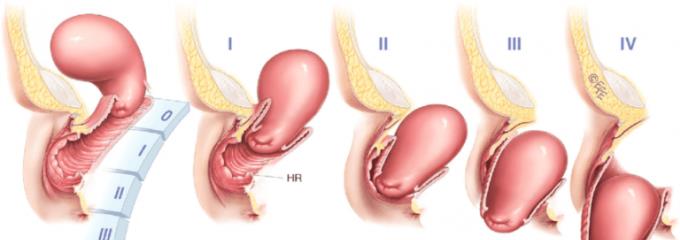Pregnancy can affect a woman in unexpected ways. The fluctuations in the hormones, physiological and psychological changes that the pregnant mother experiences will raise certain problems, such as prolapse of the uterus during pregnancy.
Although quite rare, uterine prolapse during pregnancy can be dangerous for both mother and baby. This will indirectly create problems like cervical infection , hemorrhage, premature birth and even miscarriage . The course of treatment sometimes puts a pregnant woman more at risk. Therefore, the best measure is to take precautions so that any bad risks can be avoided.
What is uterine prolapse during pregnancy?
A woman's uterus consists of many tissues, muscles and ligaments, located deep inside the pelvis. This is where the fertilized egg will implant and develop into a fetus.
Several factors during pregnancy can cause these muscles and ligaments to weaken or stretch. Lack of necessary support can cause the uterus to leave its position and descend into the vagina leading to a prolapse of the uterus during pregnancy.
Types of uterine prolapse
Uterine prolapse usually has 2 types:
Total uterine prolapse: Total uterine prolapse occurs when the uterus moves so far away from its original position that part of it appears outside the vaginal opening.
Partial uterine prolapse : Partial prolapse occurs when part of the uterus enters the vagina but does not go through it.
Stages of uterine prolapse
Weak or dilated muscles can cause the uterus to partially or even drop completely out of the vagina in different stages. Uterine prolapse usually includes the following stages:

Stage 1: The cervix slides into the upper part of the vagina
Stage 2: The cervix begins to lower to the point of being close to the vaginal opening
Stage 3: The cervix slips out of the vagina
Stage 4: The cervix has completely fallen out of the vagina.
Complications of uterine prolapse during pregnancy
Some complications when pregnant mothers encounter this dangerous situation such as:
Miscarriage
Birth difficulty
Preterm birth
Tissue ulcers
Acute urinary retention
Urinary tract infections
Mild cervical infection
Uterine rupture is fatal to both the fetus and the mother
It is the cause of other parts of the body at risk of movement, such as the rectum or bladder.
Subjects at risk of developing uterine prolapse during pregnancy
Currently, doctors cannot explain the exact cause why uterine prolapse occurs in some pregnant mothers. The good news is that this situation is quite rare, so pregnant women should not be too worried.
However, doctors have pointed to several factors such as the woman's age, BMI , increased intra-abdominal pressure, and a history of congenital muscle weakness that may put some pregnant women at risk. Must have more uterine prolapse.
In addition, if a woman has had a previous pelvic injury due to difficulty in delivery or prolonged labor is also at higher risk.
Changes in pregnancy hormones can lead to increased levels of progesterone, cortisol and relaxin. In some cases, they will cause an enlarged cervix, which can adversely affect the pelvic floor muscles holding the uterus thereby leading to uterine prolapse.
The cause of uterine prolapse during pregnancy

Some reasons why pregnant mothers encounter this dangerous situation include:
Too much squeezing due to constipation
A pelvic or fibroid tumor
Have ever had a baby that is large or difficult
The pressure in the abdomen increases
Congenital connective tissue syndrome
Excessive weight gain during pregnancy
Previous childbirth trauma leads to weak pelvic floor muscles
Severe cough caused by asthma or bronchitis
Previous surgery in the pelvic part resulted in muscle weakness
Physiological changes caused by hormonal changes that soften the cervix.
Signs of uterine prolapse
Some of the symptoms of uterine prolapse include:
A feeling of heaviness in the bottom of the abdomen
Increased vaginal discharge (in the second trimester)
Having trouble going to the toilet
Some fleshy tissue protrudes from the vagina
Have urinary problems such as urinary retention or leakage of urine
Feeling of sitting on a small ball or feeling something is falling out of the vagina.
Methods of diagnosis of uterine prolapse

Your doctor can diagnose the condition by examining the vagina and uterus. During the pelvic exam, your doctor may also ask you to push as if you were going to the toilet. This will help the doctor evaluate the extent of the uterine prolapse.
On the other hand, the strength of the pelvic muscles will also be considered through its ability to harden the pelvic muscles through the act of urination.
Treatment of uterine prolapse during pregnancy
The course of treatment is usually based on the severity of each particular case. Your doctor may recommend inserting a lift ring into the vagina. This is the ultimate aid for sagging tissues.
The rubber strap may need to be periodically removed from the body for cleaning. In severe cases, your doctor will recommend laparoscopic surgery.
Can pelvic floor exercises really help?
Pelvic floor exercises or Kegel exercises have many benefits not only in preparing women about to give birth, but also in reducing the symptoms of uterine prolapse. Studies show that women who regularly exercise pelvic floor exercises can avoid most of the problems associated with cervical prolapse. Therefore, pregnant mothers will find it helpful to make these exercises a part of their daily routine.
To what extent can pelvic floor exercises help improve the uterus?
Women with mild uterine prolapse can perform floor muscle exercises to address the symptoms and help reverse the development of the condition. On the other hand, it is important that you practice regularly and use the right techniques for them to be effective.
How to prevent uterine prolapse
Here are some helpful tips that can help you prevent a prolapsed uterus during pregnancy:
Avoid carrying heavy objects
If you have bronchitis , get treated as soon as possible
Manage your weight and avoid excessive weight gain
Perform regular Kegel exercises to strengthen the pelvic floor muscles, helping to prevent the occurrence of cervical proliferation during pregnancy.
Drink enough water, increase eating green vegetables, fruits, whole grains to limit constipation.
If pregnant women pursue a healthy lifestyle, it will reduce the risk of developing uterine prolapse. In addition, regular exercise with a reasonable diet also facilitates a smooth pregnancy and safe passing.
You may be interested in the topic:














